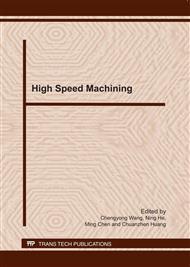p.3
p.9
p.15
p.21
p.26
p.32
p.38
p.43
Experimental Study and Modeling of Milling Force during High-Speed Milling of SiCp/Al Composites Using Regression Analysis
Abstract:
SiCp/Al composites with high volume fraction and large particles are very difficult to machine. In this present study, high-speed milling experiments were carried out on the SiCp/Al composites by the three factors-levels orthogonal experiment method, and multiple linear regression analysis was employed to establish milling force model. The results show that the milling forces decrease with the increasing of the milling speed or increase with the increasing of the feed rate and depth of milling. The influence of milling depth on the milling forces in directions of x, y is the most significant, while the influence of the feed rate on the z-milling forces are the most significant. The calculation values from the milling force model are consistent with the experimental values. The results will provide a reliable theoretical guidance for milling of SiCp/Al composites, and it is feasible to predict the milling force during the milling of SiCp/Al by using this model.
Info:
Periodical:
Pages:
3-8
Citation:
Online since:
March 2011
Authors:
Price:
Сopyright:
© 2011 Trans Tech Publications Ltd. All Rights Reserved
Share:
Citation:


